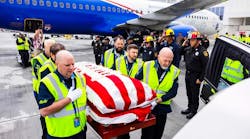EAA AVIATION CENTER, OSHKOSH, Wisconsin – (September 10, 2014) – The National Transportation Safety Board on Tuesday adopted recommendations to educate pilots on the potential impairment risks in prescription and over-the-counter medications, as use of such medications grows among the entire U.S. population.
NTSB also made six recommendations, four to the Federal Aviation Administration and two to state governments, on how to widen education efforts on impairment by such drugs as well as risks regarding marijuana use. NTSB will also issue a safety alert to pilots regarding the impairment risks of prescription and over-the-counter medications.
“The study focuses on general aviation pilots as a basis for considering the impact of medications on all transportation modes, because it is about the only data set available thanks to mandatory post mortem toxicological screening following fatal accidents. Other modes of personal and recreational transportation are not subject to these requirements,” said Doug Macnair, EAA’s vice president of government relations. “This initial step does not single general aviation out from other transportation modes. NTSB researchers told the Board several times that there is still much to learn before any conclusions can be made. The aircraft accident rate has continued to fall over the 22-year period of the study, and accidents where impairment by medications or drugs are determined to be a causal factor have not increased over that period of time.”
The recommendations came after a Board study showed that since 1990, the number of pilot fatalities involving impairment continued to be a minimal percentage. The most common drug found was diphenhydramine, often found in cold and allergy medications. The findings also showed, unsurprisingly, that prescription and over-the-counter medication use grew with the age of the pilots studied.
“Read the label and find information about these medications,” responded Dr. Loren Groff, one of the NTSB researchers, when asked by Board member Mark Rosekind what pilots should take away from the study.
The researchers also mentioned that the findings do not cast any particular conclusion on those without medical certification, such as sport pilots, who were involved in fatal accidents. Board member Robert Sumwalt asked how the study might affect the push for third-class medical certification reform, but researchers agreed that more information was needed to establish any connection.
Among the recommendations made by the NTSB were four to the FAA:
- Develop educational information for pilots about potentially impairing drugs, and make pilots aware of less impairing alternatives if they are available;
- Gather more information about the flying activity of pilots not subject to medical certification;
- Study the prevalence of drug use among pilots who are not involved in accidents;
- Develop and distribute a clear policy regarding any marijuana use by airmen regardless of the type of flight operations.
NTSB also made two recommendations to states:
- Medical providers make available much-needed information about the impairing effects of drugs – not only to pilots, but to operators of vehicles in any mode of transportation;
- Use existing newsletters for doctors, pharmacists, and any other health professionals to help educate operators in all modes of transportation.
“We agree that there needs to be more education on the effects of medications and drugs in all modes of transportation,” Macnair said. “We also believe that the medical education requirement included as part of the EAA/AOPA proposal for aeromedical reform addresses the knowledge gap that exists in the pilot population on the impairing effects of prescription and over-the-counter medications. Nothing in the medical certification process that exists today effectively accomplishes that.
“The goal of the EAA/AOPA medical reform effort is to reduce unnecessary cost and complexity of medical certification, while improving the education of pilots in a manner allowing them to make smart, informed decisions and thus enhance overall safety.”
About EAA
EAA embodies the spirit of aviation through the world’s most engaged community of aviation enthusiasts. EAA’s 185,000 members and 1,000 local chapters enjoy the fun and camaraderie of sharing their passion for flying, building and restoring recreational aircraft. For more information on EAA and its programs, call 800-JOIN-EAA (800-564-6322) or go to www.eaa.org. For continual news updates, connect with www.twitter.com/EAAupdate.


